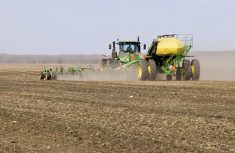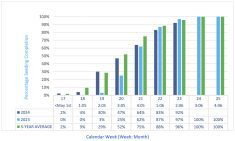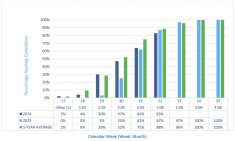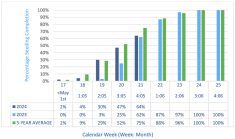Southwest Region
A mix of sun and rain last week. Repeated thundershowers with southern parts of the region getting the most rainfall last week. Continuous moisture is putting a lot of stress on moisture-sensitive crops like peas and canola. Some crops are handling better this excess moisture situation than others. Water is pooling in low-lying areas and crops are showing the signs of nutrient deficiency where soils are saturated. Growing degree-days and corn heat units are normal in most of the region but precipitation is above than normal in Southwest region this year. Soil moisture conditions are good to excessive in some areas.
Read Also

Manitoba sclerotinia picture mixed for 2025
Variations in weather and crop development in this year’s Manitoba canola fields make blanket sclerotinia outlooks hard to pin down
Wheat, barley and oats are growing well. Most of fields are at heading to grain filling stage and late seeded fields are heading right now. Most cereals are handling excess moisture conditions well. FHB spraying is nearly complete. Lodging is evident in some fields after past windy conditions.
Fall rye is ripening well and winter wheat ranges from soft dough to hard dough stage. Corn and sunflowers are benefitting from recent weather conditions. Majority of cornfields are at V7 to V9 stage. Sunflowers are R4 to R5 stage.
Field peas are at R3 to R4, with pods swelling. Well-drained fields are looking promising but the fields with low spots are showing the effects of water stress as yellowing on the edges of the fields and drowned out spots in the middle. Canola fields are also coming along. Most of early seeded crop is finishing bloom and later seeded or reseeded canola is at 50% flower. Majority of the crop got a fungicide application, as sclerotinia risk was high due to moist and humid conditions. Later seeded crops will be sprayed this week. Crop yield potential is good to average as continuous wet weather is hampering growth and pod formation. Some producers are planning to spray fungicide in soybean fields, as crop potential is looking promising. Flax fields are at full flowering stage and producers are applying fungicide as well to protect from pasmo.
Steady showers are making it difficult to put up good quality feed. Producers have started to put up silage and wrapping bales to put up some feed. Yields are average to above average. Pastures are in good condition but some producers are running into issues with standing water and foot rot. Dugouts are full.
Northwest Region
There were general thundershowers throughout the region this past week along with temperatures above 25 C. There was a system that went through to the southwest of Swan River that brought 93mm of rain causing overland flooding and issues in that area. Birch River and Inglis received 29mm of precipitation, Ethelbert 41mm with amounts in the mid- teens for the balance of the region.
Soil moisture is adequate through most of the region with the exception of The Pas where soil moisture is surplus and fields are saturated.
Spring wheat, oats and barley are heading/flowering with some earlier seeded fields in the milk growth stage. Spring cereals are generally in good condition although weed control has been a challenge. Winter wheat and fall rye are in the dough stage; winter wheat is in fair to good condition while fall rye is in excellent condition.
Hot weather and rainfall has advanced the canola this past week with the crop in full flower with earlier seeded canola continuing to pod. The staginess of canola continues within the region and, in many cases, within the same field. Some of the later seeded canola is still bolting. The canola crop condition ranges from poor to good; the crop is in somewhat better condition on the south end of the region. The soybean crop is flowering and is in good to fair condition. Flax and peas are in good condition. The peas are podding in the southern part of the region and in full flower in the rest of the region. Flax is 50% in the boll growth stage.
Bertha armyworm monitoring is underway with three traps reporting numbers in the “uncertain risk” category, one in the Swan Valley (433), on NW of Bowsman (376) and another in the Durban (427) area. Armyworms have been reported in cereals and grass crops and producers are encourage to scout for these insects.
First cut hay harvest continues to be impacted by unsettled weather across the area. Alfalfa and alfalfa/grass harvest is delayed and a second cut will be impacted. Yield is variable with closer to average amounts reported in the eastern part of the region and yields below normal in central and western areas. Quality will be reduced with harvesting more advanced stands and where swaths have been rained on. Producers are opting to harvest first cut as silage because less field drying time is need to reach the required moisture for putting up as silage. Pasture conditions continue to be variable but will benefit from the recent rainfall. Armyworms have done significant damage to some hay fields in localized areas across the region. Grasshoppers continue to be problematic and are causing damage in the Ethelbert and Grandview areas. Dugout levels are adequate.
Central Region
Sunny, warm conditions prevailed during the week with a couple of rain shower events that brought precipitation ranging from a trace in the Gladstone area to as much as 70mm in the Cartwright area. On Monday a storm system affected the southwestern part of the region west of the escarpment with localized heavy rains bringing over 90mm in the Bruxelles area according to local reports. The area east of the escarpment escaped the storm. East of the escarpment is still considered adequate for soil moisture and crops are growing well. The Portage to Gladstone areas have received minimal amounts of rainfall recently and crops and forage would benefit from some precipitation to support growth. Soil moisture conditions are rated as fair to moist for most of the region to excessive in areas that received higher precipitation recently. Some standing water visible in low-lying areas of fields that received higher rainfall. Crop is yellowing to drowning out in some of those areas that had water for a while but damage to crops is limited given the small areas affected.
Fall rye is turning colour as it is ripening. Some rye fields in the Gladstone area appear ripe already. Many fields in the Red River valley are ripening quickly and harvest of this crop could began in the next two weeks. Winter wheat is advancing into the firm dough stage.
Wheat, barley and oats are advancing rapidly and most fields are headed out even the later planted ones. Those crops are rated as good to excellent condition. With the recent precipitation, high humidity and heavy dews, fungicidal protectants have been applied to many wheat and barley fields to reduce fusarium head blight. Due to the wetter field conditions, aerial application is common. Lodging is visible in some cereal fields but limited to small areas. Corn is in the V8 to V11 stage with the odd field tasseling. Corn is growing well with the favourable moisture and higher temperatures.
Field peas are growing well, flowering to pod stage (R4 to R5). Fungicide applications to prevent blight are mostly done as the crop advances into the pod filling stage. In the Altona area, field peas are quite variable and negatively affected from earlier rains drowning out parts of fields. Many fields look good while others have suffered from excess moisture. Canola staging varies according to the seeding date and ranges from early flower for late planted or reseeded fields to podded in a few cases in the Red River Valley where crops are more advanced. With favourable moisture and higher humidity, fungicide protectants are being applied by ground and by air to early flowering canola fields for the prevention of sclerotinia. Most of those applications are done in the Red River Valley but some remain to be done west of the escarpment. Soybean fields are flowering and setting pods in the R2 to R3 stage. Edible beans are growing well and flowering. Fungicide applications to prevent sclerotinia are applied to field beans, as the crop is looking very well. Symptoms of Iron Deficiency Chlorosis (IDC) are still visible in some soybean fields but gradually fading. Flax fields are flowering well. Fungicidal protectants are being applied to early flowering flax fields to prevent pasmo, a foliar disease. Sunflowers are advancing well into the bud to head development R3 to R5 and should be flowering very soon.
Early blight in potato has been noted at Winkler and Shilo, even though spore-trapping network did not detect any early blight spores. High temperatures (>30 C) for the third consecutive week has resulted in heat stress and heat runners in many fields. There were European corn borers trapped in 10 out of 12 sites, and soon there could be borer injury in stems. Blackleg and stem rot are being reported from more fields.
Grasshoppers are noticeable in many different fields and crops. Population levels are being monitored at this time as the crops are growing well.
Water and grass is plentiful for cattle on pasture. Yields on newer, well- managed hayfields are close to average while older hay fields are below average. Beef producers are making a good start on haying and putting up round bale haylage. Greenfeed and corn silage yields look promising. Areas further north that received heavy rains earlier have standing water on pasture & lower lying native hay ground. There are many grasshoppers on hay and pasture where populations were high last year.
Eastern Region
Since last Tuesday, rainfall accumulations in the Eastern Region ranged from about five to 20mm mostly occurring as isolated thunderstorms. Temperatures ranged from seasonal to above seasonal. Some cooler, overcast days gave crops a bit of a break from the heat although conditions remained humid. There continues to be areas in central and southern parts of the region where standing water and plant stress symptoms continue to be observed. In these areas, excess soil moisture has made haying and spraying difficult reducing forage yields and annual crop yield potential. Crop stands have been thinned because of past flooding and crop development has been delayed and stunted. Corn and sunflower crops in these areas appear the most damaged with soybeans showing some signs of recovery. Current soil moisture conditions on cropland, pastures and hayland were rated as mostly adequate with the exception of previously flooded areas where soil moisture conditions continued to be surplus and excessive.
Herbicide and fungicide applications have pretty much wrapped up. Winter cereals were expected to be only a couple of weeks away from pre-harvest herbicide applications. Spring cereals were mostly in the milk stage but a few barley fields were noted as starting to turn. Canola ranged from 70% flowering to early pod filling with flowering complete. Heat blast in canola was observed. Most soybeans were in the R2 growth stage with pods evident at the lower nodes on the main stem. Corn was at early tassel while sunflowers range from the mid R3 to late R4 growth stages. Most field peas were in the late R3 to R4 growth stages. Overall crop conditions were rated as good outside of areas challenged by excess soil moisture.
Grasshoppers and armyworms remained the primary insect concerns last week with sporadic spraying continuing to occur. Agronomists and growers continued to report that grasshopper and armyworms populations were varying widely from field to field, necessitating comprehensive scouting to make spray decisions.
Haying continued throughout the region with producers wanting to finish first cut. Weather continued to make it challenging to put up dry hay. Yields were variable depending on moisture conditions. In the Stuartburn and Vita areas, where flooding occurred, the main challenge producers were facing was dealing with standing water in low-lying hay fields. Quality in these hay fields will be greatly reduced as the forages mature. Across the region, the quality of silage and baled hay was rated as good and yield reports for alfalfa/grass hay first cut remained at about 60% of normal. Second cut of pure stand alfalfa by dairy producers was in full swing and yield reports suggested an improvement over first cut. Single cut hay was likely around 50% cut with baling ongoing.
Single cut hay fields that were more intensively managed and fertilized appeared to be yielding slightly below average. Single cut hay fields that received no management or fertilizer supplementation were yielding at only about 50% of average. Yields were the lowest with wild hay and ditch hay. Insecticide applications on alfalfa and alfalfa/grass hay lands were occurring in some areas. Defoliation by grasshoppers or armyworms appeared to be the most common problem. It was noted that some hay stands were severely defoliated by alfalfa weevil. For this pest, the damage was often realized too late for insecticides to be helpful. Pastureland conditions continued to show improvement. Stands that were not put under intense grazing pressure this spring were still being rated as good although overgrazed stands were rated as fair. Beef producers remained concerned about feed supplies for overwintering and some continued to arrange with grain producers to purchase forage seed and cereal straw.
Interlake Region
Rapid crop advancement continues with warm weather and high humidity. Temperatures were in to the mid to high 20 C range, with average temperatures slightly lower than the previous week. Rainfall continues to be variable with scattered thundershowers. Amounts over the weekend ranged from 12 to 35mm for Fisherton, Moosehorn, Woodlands and Arborg. Meadows area saw as much as 50mm late in the week, with the local area seeing amounts from 25 to 50mm. Rain has been particularly welcome in those areas where ridges and lighter textured soils had moisture stress significant enough to have some premature shutdown of flowering and crop drydown. Although improvement continues, much of the region continues to register lower than normal amounts of precipitation. Temperatures have warmed enough to have normal growing degree-day (GDD) and corn heat unit (CHU) accumulation near normal.
Crops are generally looking very good. High temperatures and good moisture have allowed for rapid crop growth. Cereals are looking terrific, other than some of the last seeded or reseeded fields; heads have now emerged. Spring wheat and barley have set seed and are starting to fill, as are oats. Most of the lodged cereals have come back up over the last week. Fall rye has turned colour and harvest will soon start. Forage grass seed crops are starting to be harvested; fescues and perennial ryegrass are being taken off, no yield reports to date. Peas look excellent; flowering is all but complete, and pods are filling well. Fields that were on the drier side have smaller pods and seeds, but many look like they will have very good yields. Most peas are at R3 to late R4. Fababeans look good and flowering will soon be complete. Sunflowers are as advanced as R1 to R3.
Canola varies widely – some fields look terrific with a nice even stand; others are thin and stagey. The earliest seeded fields are fully podded; majority of fields are podding and flowering is declining, while late seeded fields are in full bloom. Rain has helped to fill in some of the gaps; many stands are thin. Soybeans have seen tremendous growth with heat and moisture, after having been stalled for 2 weeks or more. Rows are filling in. Flowering continues; most fields are R1 to early R3, with pods forming at the bottom of plants. Minimal signs of iron deficiency chlorosis (IDC) remain.
Flax continues to flower; boll formation is noticeable. Heat and moisture has been great for both grain and silage corn; all areas report rapid growth. The first tassels are showing. All crops are generally shorter than normal, but there has been quite a change in recent weeks. Successful establishment for under-seeded forages has been variable, due to significant stresses – dry soils, small seed, and insect feeding.
There have been reports of armyworms in a number of fields including perennial ryegrass, fescue, timothy, spring cereals and hay fields requiring insecticide treatment. Regular scouting has managed to keep additional damage in check.
Increasing numbers of grasshopper hotspots are being reported throughout the region, and fields are being monitored carefully. Recent rains have eased some of the pressure. Headlands are being sprayed where possible, but more entire fields are being sprayed, especially in the southwest part of the region, as well as Armstrong, Bifrost-Riverton and Fisher. Many are also spraying the adjacent ditches. All crops have been affected, including newly established alfalfa and forage grass seed fields. Head clipping is evident in some wheat fields. Diamondback moth larvae can be found in canola; crop growth is sufficient that significant damage should not be a concern with the first generation of larvae. Bertha armyworm moth trap counts have increased, but total numbers continue to be low.
Some producers have had to focus on insecticide applications and are foregoing fungicide in poorer stands.
Pastures have recovered somewhat with recent rains; but a stretch of hot dry conditions would see rapid decline. Damage due to continuous grazing in times of poor growth makes it difficult for pasture in poor condition to recover. Native hay yields will be poor in most areas due to lack of rainfall. First cut hay is essentially complete. Much of the hay saw rain prior to baling. Although better than last year in many cases, yields will be below average for most. Well-fertilized fields have fared better.
Second cut dairy hay continues. There has been more impact from the late frost than first noted, and cool dry conditions early on limited production. While forage shortages are still anticipated, the outlook has improved.


















